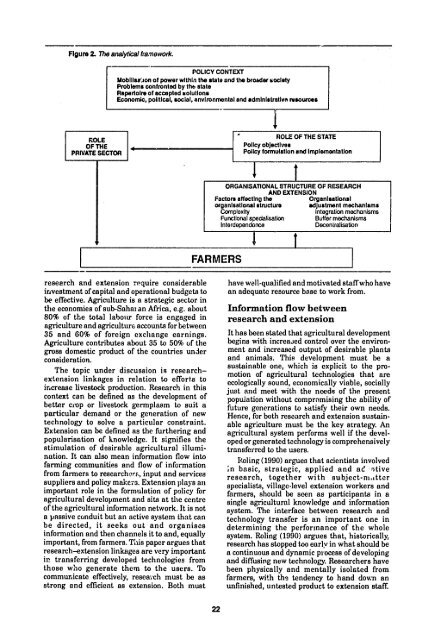aistand south~ern afrkca - (PDF, 101 mb) - USAID
aistand south~ern afrkca - (PDF, 101 mb) - USAID
aistand south~ern afrkca - (PDF, 101 mb) - USAID
You also want an ePaper? Increase the reach of your titles
YUMPU automatically turns print PDFs into web optimized ePapers that Google loves.
Figure 2. The analyical framework.<br />
ROLE<br />
OF THE<br />
PRIVATE SECTOR<br />
POLICY CONTEXT<br />
Mobllilsa'jonof power within the state and the brobder acoclety<br />
Problems confronted by the state<br />
Repertoire of accepted solutions<br />
Economic, political, social, environmental end administrative resources<br />
research and extension require considerable<br />
investment ofcapital and operational budgets to<br />
be effective. Agriculture is a strategic sector in<br />
the economies of sub-Sahar an Africa, e.g. about<br />
80% of the total labour force is engaged in<br />
agriculture and agriculture accounts for between<br />
35 and 60% of foreign exchange earnings.<br />
Agriculture contributes about 35 to 50% of the<br />
gross domestic product of the countries under<br />
consideration.<br />
The topic under discussion is researchextension<br />
linkages in relation to efforts to<br />
increase livestock production. Research in this<br />
context can be defined as the development of<br />
better crop or livestock germplasm to suit a<br />
particular demand or the generation of new<br />
technology to solve a particular constraint,<br />
Extension can be defined as the furthering and<br />
popularisation of knowledge. It signifies the<br />
stimulation of desirable agricultural illumination.<br />
It can also mean information flow into<br />
farming communities and flow of information<br />
from farmers to researchrs,, input and services<br />
suppliers and policy makers. Extension plays an<br />
important role in the formulation of policy for<br />
agricultural development and sits at the centre<br />
of the agricultural information network. It is not<br />
a passive conduit but an active system that can<br />
be directed, it seeks out and organises<br />
information and then channels it to and, equally<br />
important, from farmers. This paper argues that<br />
research-extension linkages are very important<br />
i. transferring developed technologies from<br />
those who generate them to the users. To<br />
communicate effectively, reseamch must be as<br />
strong and efficient as extension. Both must<br />
ROLE OF THE STATE<br />
Policy objectives<br />
Policy formulation and Implementation<br />
ORGANISATIONAL STRUCTURE OF RESEARCH<br />
AND EXTENSION<br />
Factors affecting the<br />
OrgansationlI<br />
organlsatlonal structure adjustment mechanisms<br />
Complexity<br />
integration mechanisms<br />
Functional specialisation<br />
Buffer mechanisms<br />
Interdependonce<br />
Decentralisation<br />
FARMERS<br />
22<br />
have well-qualified and motivated staffwho have<br />
an adequate resource base to work from.<br />
Information flow between<br />
research and extension<br />
It has been stated that agricultural development<br />
begins with increajed control over the environment<br />
and increased output of desirable plants<br />
and animals. This development must be a<br />
sustainable one, which is explicit to the promotion<br />
of agricultural technologies that are<br />
ecologically sound, economically viable, socially<br />
just and meet with the needs of the present<br />
population without compromising the ability of<br />
future generations to batisfy their own needs.<br />
Hence, for both research and extension sustainable<br />
agriculture must be the key strategy. An<br />
agricultural system performs well if the developed<br />
or generated technology is comprehensively<br />
transferred to the users.<br />
Roling (1990) argues that scientists involved<br />
!n basic, strategic, applied and ad otive<br />
research, together with subject-mtter<br />
specialists, village-level extension workers and<br />
farmers, should be seen as participants in a<br />
single agricultural knowledge and information<br />
system. The interface between research and<br />
technology transfer is an important one in<br />
determining the performance of the whole<br />
system. Roling (1990) argues that, historically,<br />
research has stopped too early in what should be<br />
a continuous and dynamic process of developing<br />
and diffusing new technology. Researchers have<br />
been physically and mentally isolated from<br />
farmers, with the tendency to hand down an<br />
unfinished, untested product to extension staff.

















